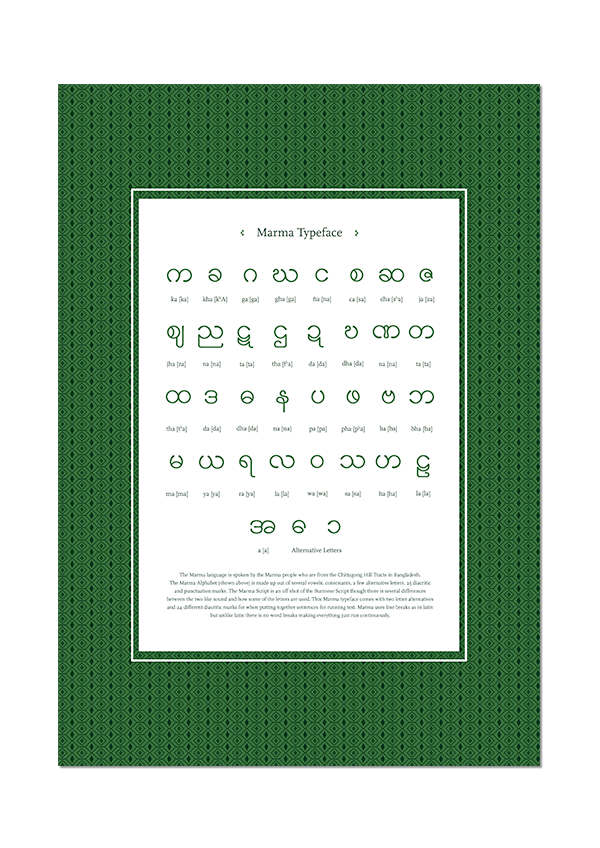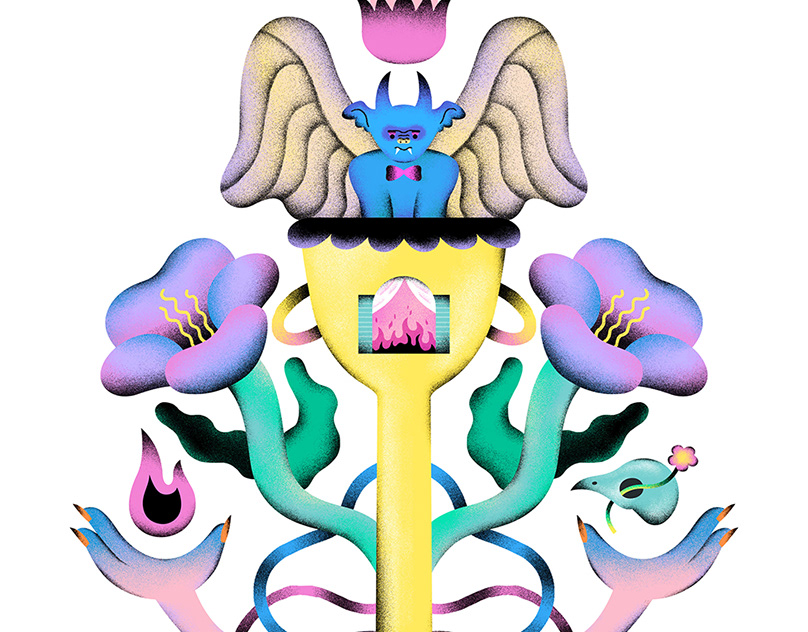

The Endangered Alphbets - Chittagong Hill Tract Project
The Marma Typeface
For my Final Major Project at Cambridge School of Art, I was asked by a teacher if I would like to join Tim Brookes and His Endangered Alphabets Project team. I jumped at the chance to join as I had a keen interest in typography, non-latin scripts and constructed languages.
The Project involved the development of several endangered writting systems from the Chittagong Hill Tracts in Bangladesh. The idea was to take scripts that are dying out and transform them into a fonts so that people could start typing with them and publish books to try and save them. For the project it was decided that I would create two of the scripts into a typeface that would be able to enter font creation stage after my deadline had come and that for the Final Major Project I would just create the vector forms of the typefaces and present them as specimen books and posters.
This is the second typeface I picked, it is called Marma.
The Marma Typeface
For my Final Major Project at Cambridge School of Art, I was asked by a teacher if I would like to join Tim Brookes and His Endangered Alphabets Project team. I jumped at the chance to join as I had a keen interest in typography, non-latin scripts and constructed languages.
The Project involved the development of several endangered writting systems from the Chittagong Hill Tracts in Bangladesh. The idea was to take scripts that are dying out and transform them into a fonts so that people could start typing with them and publish books to try and save them. For the project it was decided that I would create two of the scripts into a typeface that would be able to enter font creation stage after my deadline had come and that for the Final Major Project I would just create the vector forms of the typefaces and present them as specimen books and posters.
This is the second typeface I picked, it is called Marma.
The Marmas sometimes referred as Mogh and live mostly in the Chittagong Hill Tracts. They call themselves ‘Marma Lumya’ (Nue 2007). According to the Marma writer Kya Shai Pro the word ‘Marma’ is derived from the ‘mryma’ carrying the concept of Myanmer’s nationalism. They are the second largest ethic group in Bangladesh, According to the National Census 1991 Bangladesh has a Marma Population of 1,57,301. They are called in different name by the bifferent eithic groups living around them e.g. ‘Mran’ by the Mrora tribe, ‘Mrang’ by the Lusai and the Pangkhua Indigenous community, ‘Mraing’ to the Chakma tribe, ‘Mukhu’ to the Tripura tribe, ‘Kramo’ to the Khumi tribe and ‘Ooa’ to the Khyang Indigenous community (Ching 1998). Marmas are divided into several clans. Each clan is named after the place from where it migrated. The Marmas are fair complexioned and nose is slightly flat. They show similarities with the Burmese. They also belong to the Mongoloid. The material culture of the Marma society includes many basic tools and weapons of primitive societies. According to the philologists, the Marma language belongs to the Burmese group of Tibeto-Burman language family. The Marma alphabet ‘Marmaza’ or ‘Marimacha’ originates from the ‘ancient sub-continental Brahmin alphabet that had left-to-right writing style. It is known from a book on the ancient history of Burma, entitled, Mraina Samoing Rajwong that the people of Krishna and Godabar’ areas of south India migrated to several areas of southeast Burma in the sixth century. It is not an exaggeration to say that the Marma tongue is a dialect descended from the Burmese language. It is because a language is always like a flowing river. Therefore, as the word ‘Marma’ is derived from the Burman word ‘Mraima’. The Marma language, which has become a dialect, has been obtained from the Burmese language, one of the branches of Tibeto-Burman tongue (Shoi Pro 2002). There are 45 letters in the Marma alphabet, of them 33 consonants and 12 vowels. Lewin has divided the whole of hill populations into two groups: one is ‘Khyoung tha’ or ‘Khyoungsa’ meaning sons of a river and the others ‘Toungtha’ or ‘Toungsa’ meaning sons of a hill. About their language, he says, ‘The khyoung the Mugh (Marma) speaks provincial dialect of the Arakanese Language, which tongue was also parent stock of the modern Burmese language. The language has the strong affinities with the Himalayan and Tibetan dialects’ (Lewin 1869).
The typeface for Marma was a complex one as it is so close to the Burmese script and also while there is some hand written samples most seem to have been done using a tool to create nice geometric shapes. I decided to make use of both of these two things and create a base geometric typeface that made use of where pen marks would make thick and thin lines. By doing this I added some character to the letter forms.
More infomation on Endangered alpahbets at: http://www.endangeredalphabets.com
Working font soon.







